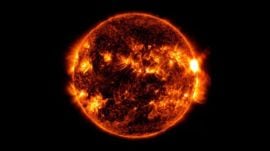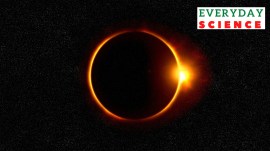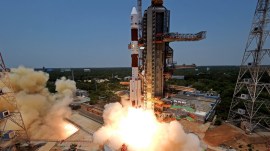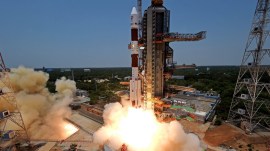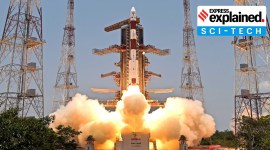Aditya-L1
The launch of Aditya-L1 comes close on the heels of the successful landing of ISRO's Chandrayaan-3 near the Moon's South Pole. The spacecraft will be travelling a distance nearly four times that travelled by the Chandrayaan missions, but just 1% of the 150 million km between the Earth and the Sun. The Aditya-L1 spacecraft is more than two times lighter than the one to the Moon.
ADITYA-L1 NEWS
Aditya-L1 Mission: First set of complete Solar Ultraviolet Imaging Telescope data released
October 29, 2025 4:39 pm
Aditya-L1, launched by the Indian Space Research Organisation on September 2, 2023, carries seven instruments to study the Sun across a wide spectral window ranging from hard X-rays to infrared.
Knowledge Nugget: Why is solar flare ‘kernel’ important for UPSC?
March 28, 2025 1:19 pm
Recently, the Aditya-L1 mission captured a solar flare ‘kernel’ in the lower solar atmosphere. What is a solar flare? In 'Beyond the Nugget', know about the major solar missions.
Capturing unprecedented details of solar flares with Solar Ultraviolet Imaging Telescope
February 28, 2025 10:02 am
The SUIT instrument onboard Aditya-L1 observed an X6.3-class solar flare on February 22, 2024, one of the most intense categories of solar eruptions. The uniqueness of this discovery lies in the fact that SUIT detected brightening in the near ultraviolet wavelength range.
Indian satellites suffered no outages during recent high-intensity solar storms, says ISRO
May 15, 2024 11:27 am
Aditya L1 and Chandrayaan-2 captured the sun's wild side during the solar storms on May 10 and 11.
How solar eclipse will help study Sun, why Aditya L1's view will not be blocked
April 09, 2024 11:12 am
Indian solar physicists are in the US to the study Sun's inner corona during the April 8 total solar eclipse that is visible from North America.
Diagnosed with cancer on day of Aditya L1 mission launch, cured now: ISRO chief S Somanath
March 04, 2024 7:19 pm
S Somanath said he had realized that there were some health issues during the launch of the Chandrayaan-3 mission but was not very clear about it.
Aditya-L1, ISRO’s first mission to study Sun, in final orbit; another landmark, says PM Modi
January 07, 2024 8:08 am
Aditya-L1 moved into the ‘halo’ orbit around the L1 point in the Earth-Sun system, from where it will make observations of the Sun for the next five years.
Solar mission: Aditya-L1 successfully enters final orbit; PM, President laud 'extraordinary' feat
January 06, 2024 10:31 pm
Aditya-L1 was successfully inserted into the Larange Point 1, one of the five locations in the Earth-Sun system where the gravitational effects of the two roughly cancel each other out.
Aditya L1, ISRO’s mission to study Sun, set to be placed in final orbit tomorrow
January 05, 2024 10:34 am
The Indian Space Research Organisation (ISRO) had launched Aditya L1 on September 2, last year.
Aditya L1 corrects trajectory as it moves closer to Sun: Why, how was this done?
October 09, 2023 10:11 am
The Aditya L1 is to undertake a 110-day journey through space, one of the longest for an Indian spacecraft since the 2013-2014 Mars mission. Here's why it needed a Trajectory Correction Maneuver.
Best of Express








